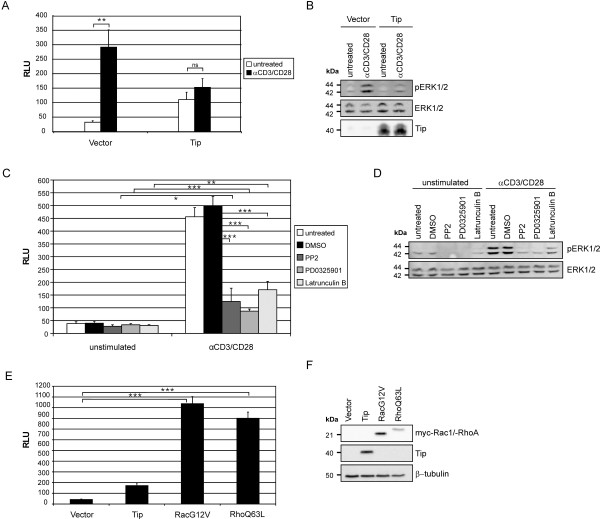Figure 5.
SRF activation by TCR engagement and by constitutively active Rac1 or RhoA. (A) Jurkat T cells were transiently transfected with p3D.A-Luc and vector or expression plasmids coding for Tip and stimulated for 14 h in 6-well plates coated with antibodies directed against CD3 and CD28 (αCD3/CD28). Reporter activation is summarized as mean values and standard error of five independent experiments. Statistical significance, p > 0.05 (ns); p < 0.01 (**). (B) Representative immunoblots for the cells used in (A) displaying ERK1/2 phosphorylation and expression as well as Tip expression. (C) Jurkat T cells were transiently transfected with p3D.A-Luc and vector. Cells were treated with PP2 (10 μM, 40 h), PD0325901 (1 μM, 40 h) or Latrunculin B (1 μM, 24 h) and stimulated for 14 h in 6-well plates coated with antibodies directed against CD3 and CD28 (αCD3/CD28). Reporter activation is summarized as mean values and standard deviation of three independent experiments. Statistical significance, p < 0.05 (*); p < 0.01 (**); p < 0.001 (***). (D) Representative immunoblots for the cells described in (C) displaying ERK1/2 phosphorylation and expression. (E) Vector and expression plasmids coding for Tip, myc-Rac1-G12V (RacG12V) or myc-RhoA-Q63L (RhoQ63L) were cotransfected with p3D.A-Luc. The graph summarizes data of five independent experiments. Statistical significance, p < 0.001 (***). (F) Representative immunoblots displaying myc-Rac1-G12V, myc-RhoA-Q63L and Tip expression. Detection of β-tubulin served as a loading control

